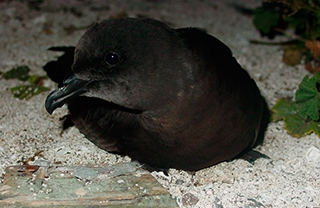|
| Query: bird | Result: 4012th of 32675 | |
Bulwer's Petrel (Bulweria bulwerii) - Wiki
| Subject: | Bulwer's Petrel (Bulweria bulwerii) - Wiki
| |

| Resolution: 320x208
File Size: 59018 Bytes
Date: 2005:01:21 19:43:58
Upload Date: 2007:12:12 16:11:17
|
Bulwer's Petrel
From Wikipedia, the free encyclopedia
Order: Procellariiformes
Family: Procellariidae
[Photo] Bulwer's Petrel Bulweria bulwerii. Source: USFWS
The Bulwer's Petrel (Bulweria bulwerii) is a small petrel in the family Procellariidae, and is one of two species in the genus Bulweria (Bonaparte, 1843). This bird is named after the Scottish naturalist James Bulwer.
Description
This very long-winged petrel is 25-29 cm in length with a 78-90 cm wingspan. It has mainly brown plumage and a long pointed tail. It has a buoyant twisting flight as it picks planktonic food items from the ocean surface.
Breeding and habitat
This seabird breeds in the north Atlantic in colonies on islands in the Cape Verde Islands, Azores, Canary Islands and Madeira groups.
Bulwer's Petrel also breeds on islands across the north Pacific from east of China to Hawaii. After breeding, birds disperse to spend the rest of the year at sea, mainly in tropical waters. This species has been recorded in Europe as a rare vagrant to Ireland, Great Britain, Portugal and the Netherlands. It has also appeared as a vagrant in North America, with rare sightings far off the coast of both California and North Carolina.
http://en.wikipedia.org/wiki/Bulwer's_Petrel
| The text in this page is based on the copyrighted Wikipedia article shown in above URL. It is used under the GNU Free Documentation License. You may redistribute it, verbatim or modified, providing that you comply with the terms of the GFDL. |
|
^o^
Animal Pictures Archive for smart phones
^o^
|
|

